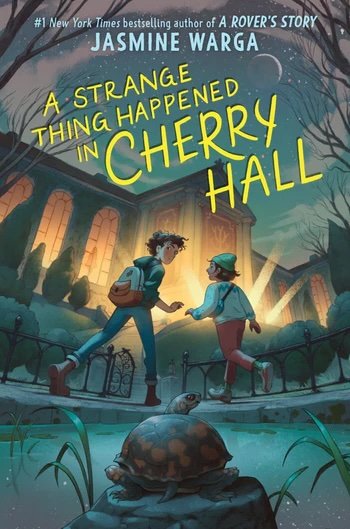Process Talk: Jasmine Warga on A Strange Thing Happened in Cherry Hall
At the ABA Children’s Institute in New Orleans this summer, I ran into Jasmine Warga and picked up an ARC of her middle grade novel, A Strange Thing Happened in Cherry Hall. It’s a delightful middle grade that spins outward from the main character’s diffidence and self-deprecating humor to a theft at the museum where his mother works as a cleaner. The starred review in Kirkus calls it a “slowly unfurling delight.”
Here’s my email conversation with Jasmine about the book:
[Uma] As you may know (or maybe you don’t so I’ll tell you) I’m always on the lookout for secondary characters with origins or links in South Asia, so I was immediately interested in Veda, Rami’s friend. Talk about the dynamic between them. They are so different, and yet they make a terrific team. How did this particular friendship take shape for you as you wrote this story?
Warga and daughter in an art museum. Photo courtesy of Jasmine Warga
[Jasmine] Rami appeared to me first. I understood his character before I knew Veda would be a part of the story. But once I wrote the library scene, Veda instantly enlivened the story. I saw she was exactly what Rami needed—someone to push him out of his comfort zone, someone who was adventurous and boisterous. And Rami similarly provided a good foil to Veda—he sees her and appreciates her. I like writing characters that complement each other well, and I find unexpected friendships particularly satisfying to write. For me, while there is the main mystery in the story—who stole the painting?—the book is really about the mystery of self-discovery, figuring out who you are, and how you relate to other people, and Rami and Veda’s friendship is emblematic of this exploration.
[Uma] I was also much taken with the turtle. Her placement in the story intrigued me. I found myself looking forward to the passages where she appeared. Can you talk about how you came to place a slow moving animal with many insights in a story where the main character would've been happy to hide himself in a shell?
[Jasmine] Yes! Thank you for appreciating the turtle. Agatha was added when I found myself wanting to add an extra dash of intrigue and fun to the story. I personally love stories with unexpected narrators. I was also thinking—this is a story about noticing things that are often overlooked, and what in our world is often overlooked? Small, slow-moving creatures like turtles.
“I wanted the book to feel classic and charming—almost like you were living inside of a quirky French film. It was so much fun to write in this voice. ”
[Uma] There's a delicious omniscient voice in the story. It floats in on the chapter titles, offers little humorous parenthetical asides, and adds context. Did you know from the start that you’d tell the story this way or if not, how did this come to be?
[Jasmine] I knew I wanted to write the book in a style that would harken back to the books I loved as a kid like The Mixed Up Files of Mrs. Basil E. Frankweiler, and The Westing Game. Tonally, I wanted the book to feel classic and charming—almost like you were living inside of a quirky French film. It was so much fun to write in this voice.
[Uma] Classic and charming—yes, I was definitely reminded of The Mixed Up Files…. Can you talk a bit more about that joyfulness? Why do you think the voice lent fun to your process? Was it nimbler, more expansive than one with a more limited viewpoint? Or something else?
[Jasmine] I feel like writing in such an arch and whimsical third-person voice allowed me to be more playful. It was my first time writing in a narrative voice that understood more than my point-of-view character, and getting to explore the distinction between a narrator and a character, which allowed for a more expansive and different type of storytelling. It allowed me to be more playful not just in terms of language, but also in terms of plotting and pacing because I wasn't confined to just one specific character's perspective.
[Uma] I’ll close with a passage from the book:
“What's the name of the painting?" he asked.
“It doesn't have one.”
He smiled slightly. “Untitled for now. I get it.”
“I knew you would,” she said.
It is a singular feeling to be understood. Seen. Connected. It is the best feeling in the whole world.
With its mystery, its setting, and its friendship between lovable, offbeat characters, here’s a middle grade novel that turns strange into singular, in the best way. Congratulations, Jasmine!

